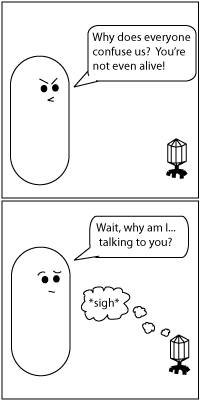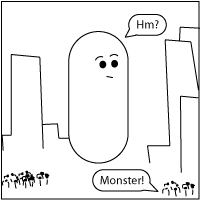Virus? Bacteria?
This is a very common question: what is the difference between viruses and bacteria? These two little guys often are mixed up because they both are quickly dubbed “those things that make us sick.” For a full explanation on this with regards to bacteria, see the “Bacteria” article.
 To illustrate how not only separate but wildly different these two babies are, remember that bacteria are alive. Yes, they are teeny tiny life forms that live in the ocean and in your nose. Lovely, great, wonderful. Now, viruses… viruses are not technically speaking “alive.” That doesn’t mean they are dead (because you must at one point be alive to then be dead); it means they are “non-living.” When thinking about viruses’ being in the same category as other non-living things, like say, rocks–it can be a difficult idea to take a walk with. Non-living things don’t seem as though they should have a big effect on our bodies.
To illustrate how not only separate but wildly different these two babies are, remember that bacteria are alive. Yes, they are teeny tiny life forms that live in the ocean and in your nose. Lovely, great, wonderful. Now, viruses… viruses are not technically speaking “alive.” That doesn’t mean they are dead (because you must at one point be alive to then be dead); it means they are “non-living.” When thinking about viruses’ being in the same category as other non-living things, like say, rocks–it can be a difficult idea to take a walk with. Non-living things don’t seem as though they should have a big effect on our bodies.
Let’s stop there a second and think about that though. Let’s take a non-living thing like salt. Too little salt (iodized salt) and you can develop an unpleasant illness called goiter. Too much salt can give you diarrhea, make you vomit, even kill you. (If you are even stranded in a dingy in the middle of the ocean, remember that.) Salt is not alive, but it has quite the effect on our bodies.
The obvious difference, of course, is that we can choose how much salt to put in our bodies, but with viruses we get almost no say in the matter. They are opportunists that can enter the body through open wounds, mouths, noses, eyes, etc. This certainly makes them sound alive, if not devious and just plain rude. But they aren’t!
Okay, okay, I’ll explain. Basically, a living organism has to have the following characteristics:
- DNA
- The ability to reproduce itself
- Responsiveness to its environment
Depending on what you’re reading, there may be more, but these are the basics. Now, viruses do have DNA (sometimes RNA), and you could argue that they respond to their environment, but guess what they don’t have at all? Ding ding ding! The ability to reproduce themselves! Viruses do not possess the cellular machinery to make more of themselves. All they are is a protein shell with some DNA (or RNA) inside. What makes them so inconsiderate is their use of our innocent cells to do their reproduction bidding. They get inside your cells, hijack your organelles, and produce hundreds of copies of the virus. When they are all done, they destroy the cell completely as they burst out of its membrane looking for more cells to infect in order to reproduce. When you have a virus like the cold or flu, your symptoms are usually caused by cell damage and your body’s attempts to get rid of them. Bright green mucous in the nose means it is full of dead cells–they are the casualties of the war going on in the body.
So viruses are not technically alive, but they have been around a very long time. Some scientists theorize that viruses were the precursor to life on earth. If you think about this for a moment, it doesn’t quite flow though because viruses can’t reproduce without a host cell… and if viruses came first… what host cell did they use to reproduce? Um, I’m sorry, but I don’t know either.
There are other theories about viruses that show a friendlier, more helpful side of the little protein bubbles: some scientists think they are a major cause of evolution. Think about it. They are built to inject DNA into other cells. At some point, they could have gone about injecting new genes into other cells in some sort of primordial soup of simple creatures. If the DNA a virus injected made that creature stronger in some way, then hey! that trait would have gotten passed down and helped move evolution along.
Wow, all this time, and I still haven’t answered the question of the difference between a virus and a bacterium. Let’s discuss their differences as we consider how they can affect our bodies. (I know I said we shouldn’t just focus on their negative effects on our bodies, but I can’t entirely avoid the issue, can I?)
 Think of your body as the city of Tokyo. Don’t argue with me; just do it. Okay, now you body is the city, and a bacterial infection could be represented as Godzilla. Godzilla is bumbling around stepping on people (the cells of your city), knocking over buildings, ruining roads–just causing all out havoc… by accident. Godzilla is not evil. He wasn’t plotting his assault on Tokyo from the bottom of the Pacific. He’s just in the wrong place at the wrong time, and yeah, it’s not going well. The upside is that it is pretty easy to tell the difference between members of the city of Tokyo (your body) and the intruder, Godzilla (bacteria). Without too much heartache, bacteria can be removed from the body, and Tokyo can get back to normal. (This, of course, assumes we’re not dealing with a strain of antibiotic-resistant bacteria, which you can also read about.)
Think of your body as the city of Tokyo. Don’t argue with me; just do it. Okay, now you body is the city, and a bacterial infection could be represented as Godzilla. Godzilla is bumbling around stepping on people (the cells of your city), knocking over buildings, ruining roads–just causing all out havoc… by accident. Godzilla is not evil. He wasn’t plotting his assault on Tokyo from the bottom of the Pacific. He’s just in the wrong place at the wrong time, and yeah, it’s not going well. The upside is that it is pretty easy to tell the difference between members of the city of Tokyo (your body) and the intruder, Godzilla (bacteria). Without too much heartache, bacteria can be removed from the body, and Tokyo can get back to normal. (This, of course, assumes we’re not dealing with a strain of antibiotic-resistant bacteria, which you can also read about.)
Viruses, on the other hand, are more like a secret agent with a bag full of grenades. He’s walking around, unnoticed, going into buildings and setting off explosions, and disappearing into the crowds. He is causing all kinds of damage, and no one can tell where it’s coming from. Because no one can find him, no one can get rid of him. Very different way to affect a city/body (if you can keep hanging on to this metaphor).
So now you know that viruses and bacteria are wildly different albeit tiny things. They both have a dark side (a side we are all too familiar with), but I hope I made it clear that they are not all bad; certainly not worth being angry with. So the next time you find yourself cursing the virus that gave you your cold, remember you might as well direct your anger at a refrigerator magnet–because there is no one at fault or worth blaming. Just drink some tea and be the intelligent vertebrate I hope you are, and let the anger go. The virus can’t understand you.










